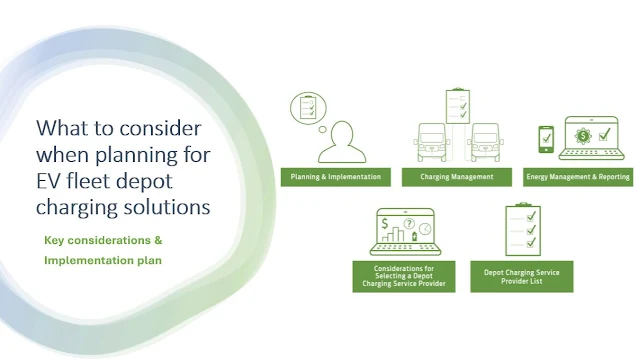How to plan for EV fleet depot charging solution | Typical Implementation plan
Electric fleets with centralized operations or with vehicles parked at a garage overnight may find depot charging to be the perfect charging solution. With upfront planning and optimized design there are many technical solutions to improve operational efficiency and reduce costs – not to mention sustainability benefits. This post shall give an overview on Planning, Implementation, Charge Management and Energy Management for depot charging.
PROCESS OF A TYPICAL DEPOT CHARGING SOLUTION PLANNING
Planning for your charging depot may seem overwhelming at first, but there are several key elements that can simplify the process.1. Engage upfront with your utility and depot charging provider: Recommended as early as possible in the process. Long lead time may be needed for zoning considerations, jurisdictional approvals or installation factors such upgraded or new facility electrical infrastructure or utility service upgrades.
2. Understand the load requirements that will be added to your site: Depot charging may introduce new factors to your fleet because electric vehicles add to the power load to your site. It is important to understand the load profile that will result from your electrified vehicle fleet. That is, how much power does your fleet need to use when it is charging and how does that vary over time? Your fleet composition, dwell time between shifts or runs, vehicle battery sizes, vehicle routes and duty-cycles will be important considerations.
Depot charging service providers can help by evaluating existing site power load and comparing it to the new power load that will be required to charge your vehicles. Site visits, facility management and utility interface should all be part of this process.
3. Create organizational interface between facility and fleet managers: Depot charging may bring together your facility or site management, local utilities and vehicle fleet management in ways that have not been experienced previously given new energy dependencies between your fleet and facility. It may be that these organizations have not interfaced at an operational level before and may even have different management structures, budgets, and planning time horizons.
4. Plan with long term electrification time-horizon in mind: It is important to incorporate your future electrification transition plan to avoid future infrastructure tear-ups and unexpected or unnecessary costs. Planning with this time-horizon in mind is a key input to your site and implementation planning, including elements of future-proofing that not only apply to hardware, but also for the power load that your site will accommodate over time. This is especially important for planning of charging and energy management solutions.
5. Plan for incentives: As outlined on page 5, your depot charging service provider can help you identify any infrastructure-related incentives to incorporate into your planning.
6. Understand back-up and emergency requirements: Uptime is paramount for fleet operations. Planning for robust back-up power can help to ensure you have emergency generation or even more advanced off-grid solutions available.
7. Develop project plans with estimates for timing and costs: A comprehensive project plan can be a valuable tool to help ensure your charging solutions are on time and have realistic budgeting estimations and reliable cost and timing projections.
Development of the plan may also necessitate certain trade-offs to consider when balancing requirements, timing, and costs – all while mitigating inherent uncertainty in the implementation process. It can also be helpful to have the same firm develop the plan and deliver the plan.
8. Evaluate advanced energy management options: If you plan to introduce large numbers of electric vehicles for scaled operations, there are many exciting solutions that you may want to explore with your depot charging service provider.
8. Evaluate advanced energy management options: If you plan to introduce large numbers of electric vehicles for scaled operations, there are many exciting solutions that you may want to explore with your depot charging service provider.
These solutions can boost your sustainability goals and provide back-up power, improve efficiencies and/ or reduce costs. Specialty solutions for advanced energy management include fleet and site power management, renewable integration, on-site energy storage, microgrids and other novel and emerging technologies. Basic guidelines should be:
- Understand charging
and energy management options to avoid any unnecessary electrical infrastructure
upgrades, save energy, minimize number of chargers to install, and more
- Understand electric
utility rate schedules and available grid services to help optimize
charging schedules and charging equipment selection
- Understand electric utility rate structures to minimize demand charge impacts. Demand charges may occur if there are new peak power load draws at your site.










Post a Comment